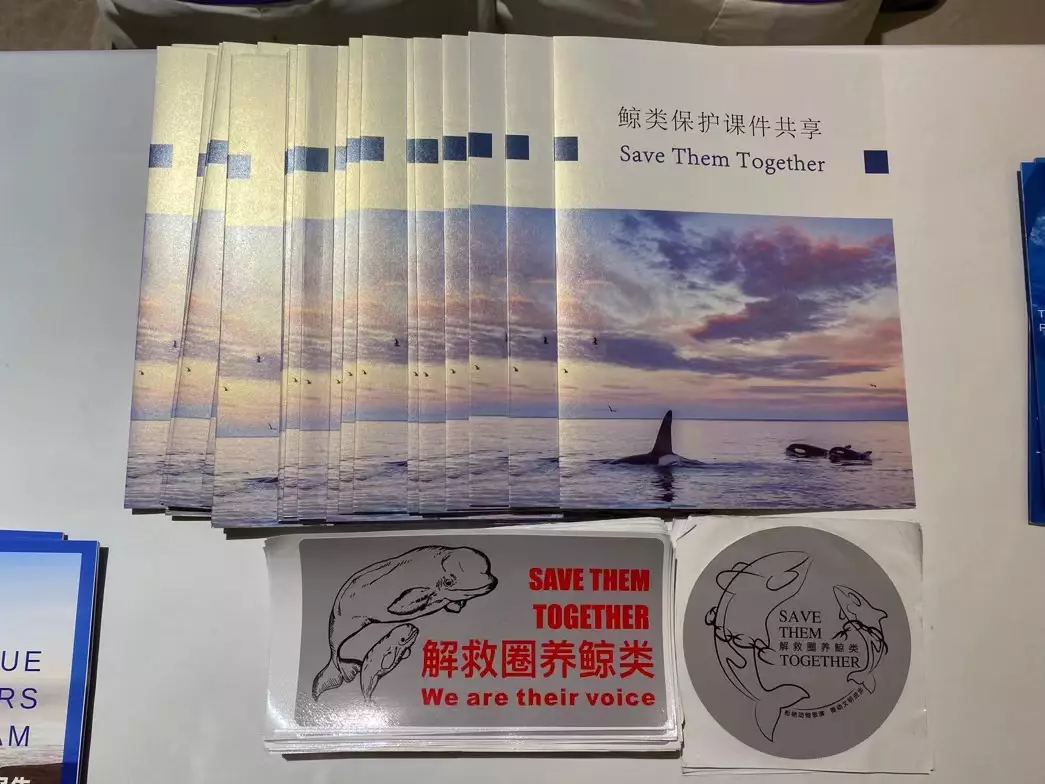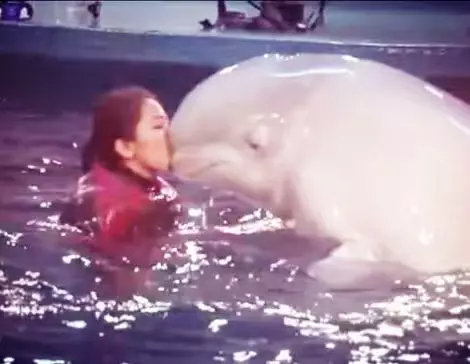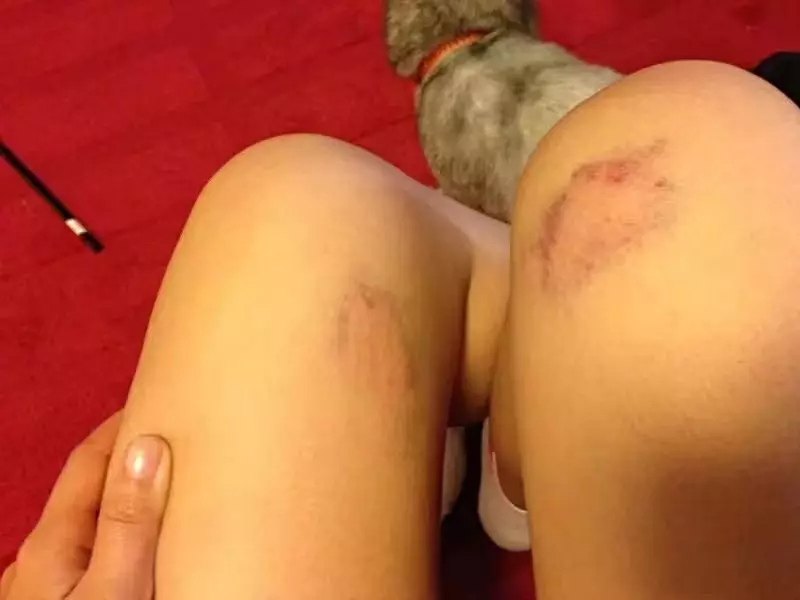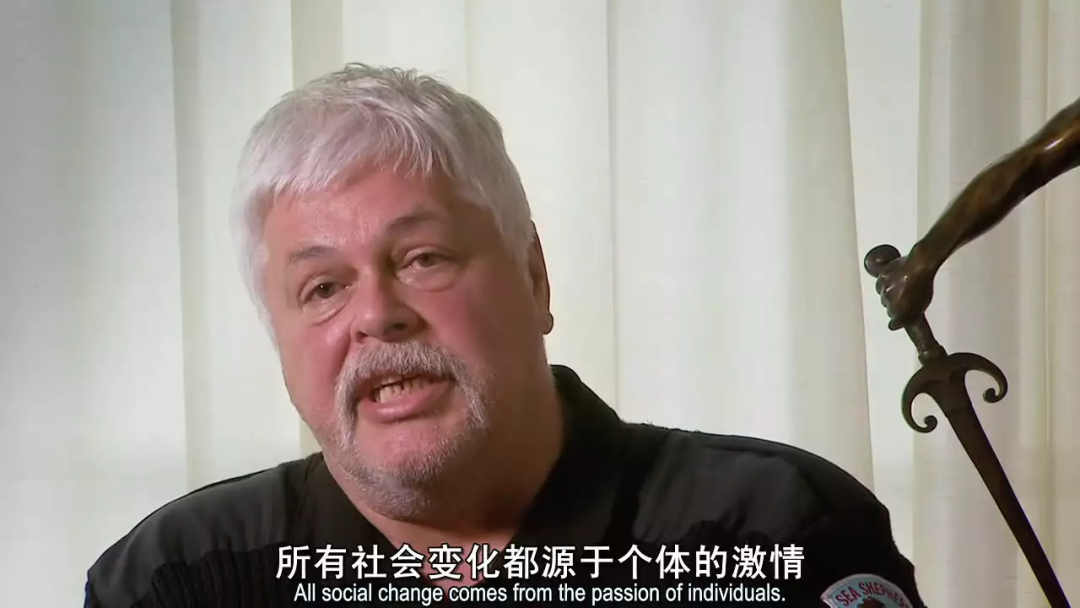I will keep sharing Huahua’s and Sophie’s stories until our country outlaws performances featuring animals. — Shao Ran/邵然
Translator’s Note: The orginal article was published on BIE on December 16, 2022. I translated it to English with Shao Ran’s permission.
At the fourth Ocean Conservation Forum held earlier this year (2022), Jincao Carnival, a public platform for biodiversity awareness, hosted a week of activities that brought frontline animal protection workers together with the general public. It was during this event that we first met Shao Ran (邵然).
Shao Ran didn’t have a booth, but she came anyway, carrying stacks of pamphlets she had printed herself on rescuing captive cetaceans. She tried to speak to everyone who paused, sharing the story of her journey with whales. Her voice was soft, even a little hesitant—but when she talked about her cause, a quiet yet unmistakable resolve came through. That was what drew us in.

Shao Ran’s pamphlets
In the conversations that followed, we learned that Shao Ran was once a whale trainer and animal show host.After witnessing their suffering firsthand, she became an ocean conservation advocate—determined both to rescue whales and to overcome her own traumatic memories.
Her story reminded me of Richard O’Barry, the former star dolphin trainer featured in the documentary The Cove. After the dolphin he had trained took its own life in his arms, O’Barry devoted the rest of his life to fighting dolphin captivity. Naturally, this documentary came up in our talks with Shao Ran as well.
“A few years ago, I learned that the biggest buyers from Taiji, Japan, were marine parks in China,” Shao Ran told us. “Some of the parks I worked with got their animals from there. Taiji is the same town from The Cove.”
That job at the marine park was Shao Ran’s first—and only—job. It was where her dreams both came true and fell apart.
She was 23. That was eleven years ago. What follows is her own account.
“South China’s First Female Whale Trainer”
I became a whale trainer by accident, really.
I didn’t finish high school. I later enrolled in a correspondence program just to get a diploma, but never actually attended any classes. I’d always loved visiting marine parks as a kid, but I assumed this kind of job required highly specialized qualifications, so I never imagined it could be for someone like me. I just admired the trainers from afar.
Then one day, I happened to see a dating show where one of the contestants said he worked as a dolphin caretaker. When people asked how he got the job, he said he’d just found it online—and he hadn’t even studied anything related. That was the first time it occurred to me that maybe regular people could do this work too. You just had to be young, willing to work hard, and like animals.
So I started searching for jobs online and saw an opening at a marine park in Shenzhen. I’d never left Beijing before. Just the thought of working by the sea, being with animals every day—it felt like a dream. So I went. On the way there, I told myself: if they don’t hire me, I’m not leaving. Maybe it’s because that’s the kind of person I am—when I want something, I go all in, no plan B. I was ready to use the same strategy here.
By the time I applied, I was already a little old for an entry-level animal caretaker. But the park happened to be short-staffed, so they decided to assign me to be a whale trainer. I hadn’t been there long before I started getting in the water. At the time, there were no female whale trainers in all of South China, so the park launched a marketing campaign calling me “South China’s First Female Whale Trainer.” A few TV stations even came to interview me. At first, my parents didn’t understand what I was doing—they kept saying I’d gone off to work in some fishing village feeding fish. It wasn’t until they saw me on TV that they finally felt proud.
I worked as a whale trainer for over two years. Eventually, because I was always soaking in cold water, my rheumatism flared up and I couldn’t keep getting in the pool. I switched to training sea lions and hosting performances, and stayed in that role for over five years total. But honestly, even in the first year, I’d already realized the job wasn’t what I’d imagined. There were times I found myself hitting or shouting at animals. But in that kind of environment, your access to information is so limited. Everyone around you is doing the same thing. Still—it’s not just about others. I had responsibility too.
In China, animal training isn’t considered a technical trade. There’s no formal training, no professional standards. It’s just a master-and-apprentice system. You watch how your mentor cuts up fish, how they prepared the feed, and you copy. These mentors had no background in marine science or animal behavior, and no one expected you to learn anything about the animals’ needs. Ethical questions? Those were never mentioned. Not because we were forbidden to talk about them—but there was just this unspoken rule: no one brought it up.
I think part of the reason is that most of my coworkers were also very young, with little life experience, or like me, not well-educated. Many were sixteen or seventeen, just out of rural towns. Some lacked basic empathy toward animals. They wouldn’t even consider questions like compassion or animal welfare. To us, these creatures were tools. At least during my time there, I didn’t reflect on these things much, and I didn’t see others doing it either.
Before we started the job, we were given no information about the whales we were caring for—nothing about their behavior in the wild, what kind of environment they need, what they eat, how they relate socially. But once you understand those facts, you realize they’re fundamentally incompatible with keeping these animals in captivity. The more you learn about their natural lives, the more sharply it clashes with what you’re doing at work—and that’s a contradiction you simply can’t reconcile.
If you look at marine parks today, you’ll see their public education materials are extremely superficial. They rarely mention anything that might suggest captivity is harmful—for example, how much whales swim every day in the wild, how they dive hundreds of meters while our tanks are just seven meters deep, how their diet in the ocean is rich and varied while we feed them only frozen, dead fish. If you talk about these things too much, it doesn’t just undermines the audience’s trust but also confuses new staff. So nobody talks about it. We don’t bring it up with each other, and we certainly don’t talk to the public.
I didn’t either. It wasn’t until I left the marine park, in recent years, that I began to reflect—again and again—on those memories. The one I think about most often is a dolphin named Huahua.
The Suicidal Dolphin
Huahua was a Risso’s dolphin—not especially beautiful, her body marked by scar-like patterns. She lived alone in her own tank, without any companions, always isolated. Occasionally, she could hear the sounds of other animals, but that was it.
Later, her tank was scheduled for renovation, so the park moved Huahua into the beluga pool which I was in charge of. The tank was about the same size as the one she had lived in before, but now there were two unfamiliar whales—neither of them her species. This made Huahua extremely uncomfortable. One of the belugas was young, the other had cataracts. They didn’t mean to be aggressive, but they instinctively bullied the newcomer. In that kind of enclosed space, Huahua had nowhere to escape. It was suffocating.
One evening before finishing work, I went to feed the belugas as usual. Huahua swam toward me, nuzzling like she was seeking affection. But I instinctively pushed her away. She was like a child who had never known love—if you smiled at her, she’d be happy to play with you; if you so much as frowned, she would shrink away, as if she already knew she wasn’t wanted. But that day, Huahua was different. Even after I pushed her away, she kept trying to get close. I kept brushing her off, telling her, “Go away. Your trainer will be here soon. Don’t bother me while I’m working.” After several times, I started to feel annoyed. The two belugas, seeing me react this way, also began to lash out—lunging at her and trying to bite her. I still didn’t respond to her distress.
The next morning, when I came to work, I found Huahua dead.
She must have been in great pain in her final moments, which is why she had acted so unusually—reaching out to me. And I had turned away in coldness. So she chose to stop breathing and sank to the bottom of the tank, ending her life.
When we found her body, we noticed that both belugas had wounds around their mouths—injuries they’d likely received while trying to push Huahua to the surface to breathe. They tried, but they couldn’t save her.
Later, a vet from Hong Kong Ocean Park came to perform a necropsy. I waited beside them the whole time, hoping for an explanation. I wanted to believe she had died of illness. I didn’t want to believe that when a life had reached out to me in its final moment, I had offered only rejection. I wanted an answer that would let me feel some kind of absolution. But it never came.
Back then, I was just overwhelmed—crying nonstop. Only later did I learn that cetaceans breathe consciously. They can choose to keep breathing—or to stop. Suicidal behavior among captive whales and dolphins is not unheard of.
Even now, I still feel deeply guilty whenever I talk about it. I’ve never been able to move on. I nearly fell into depression. I used to be an optimistic person—when I realized I was feeling down, I would avoid the things that triggered those feelings. But this has stayed with me. It’s something I’ll carry for the rest of my life. I can never forgive myself.
What truly pushed me to start thinking, to want to make change, was another whale I once cared for—a beluga named Sophie.

Me with Sophie the beluga whale
Sophie was never willing to accept life in captivity. The other belugas she lived with could still be coaxed into performing in exchange for food. But not Sophie. She was in pain. She was suffocating. At first, she didn’t bite. But when one of the trainers kicked her, she began retaliating—biting trainers’ feet. Her aggression escalated with time.
Her anguish built up, day after day, until finally it exploded. During a performance, Sophie attacked me relentlessly. She seemed determined to kill me—grabbing my foot, dragging me underwater again and again. Her eyes were wild, the whites showing. In that moment, there was no rescue plan for trainers. All you can do is pray for the whale’s kindness. You put your life in her flippers and hope she’ll spare you—so that you can go on exploiting her gentleness.
There were so many people there that day, watching from the audience as she attacked me, as she lost control. The music never stopped. The show went on. In that moment, only I could feel her agony and desperation.
But in the end, she let me go.
When she saw me frozen with fear, Sophie swam over, gently pulled me back to shore, and looked at me with tired, broken eyes. It was as if she were saying, “Let’s do it—go on with the show. I’ve given up.”
So I got back in the water and finished the performance with her. As we performed, I noticed discharge coming from her half-open eyes. Normally, cetaceans do secrete some fluid from their eyes. But in that moment, I could only feel that she was crying.
Seeing that, I couldn’t hold back my tears either. But we were underwater. No one saw. The audience, unaware, erupted into cheers and applause. Their joy filled me with a deep, paralyzing fear.
My heart shattered. I couldn’t help asking myself: What kind of world am I living in? Why do adults and children find joy in the suffering of other beings? How did we come to believe that stealing the freedom of another life and enslaving it is something to be proud of?
That was the moment I decided to leave. I would go into schools and tell the truth to as many children as I could.

Scars from when Sophie bit me
Sometimes I think—maybe I’m not actually an animal lover.
My affection for animals isn’t as deep as people imagine. I don’t have a strong curiosity to learn about them, nor a burning desire to explore. I first entered this line of work simply because I thought dolphins were cute. I wanted to play with them. I wanted to have them.
Even now, doing marine animal education and advocacy, I wouldn’t call myself someone with deep expertise in cetaceans. But I know what’s wrong. So at first, I wanted to protect animals. Later, I wanted to protect children, too. I wanted to protect China’s future. I don’t want to live in a society where life is treated with such indifference.
And because I was complicit—I was part of it—I have a responsibility, a duty to speak out.
Don’t Cheer for Pain, and Don’t Be Fascinated by Cages
There’s a dream I keep having at night.
In the dream, I’m trapped in a tank with the marine park animals. I pound on the glass with everything I’ve got, but no one comes. No one lets me out. I’ve had the dream so many times that I’ve grown terrified of small, enclosed spaces. I can’t take elevators. I can’t sit in the inside seat of a car. The claustrophobia has gotten worse over time. I think it’s because, the more I reflect on what happened, the more deeply I understand the animals’ suffering.
Some dismiss it as imagination: ‘How can you prove animals suffer? We need data, scientific evidence.
But science is still limited. There’s so much we can’t yet prove. And when you’re facing a living, breathing creature—shouldn’t their pain come before data? Why should we be slaves to numbers?
It’s our ability to perceive and respond to others’ emotions that forms the foundation of civilization. If someone can’t even recognize another being’s pain, what does it mean to be human?
In China, we’ve always emphasized scientific theory. But for a long time, we’ve neglected to teach young people what it means to be a civilized human being. I once gave a talk at a well-known ecology department in a Shanghai university. Afterward, I received over twenty letters from students. Most of them acknowledged how much the animals were suffering. And yet, many still felt those individual animals’ sacrifices were necessary for the greater good—to help humans understand and protect wild populations.
I don’t agree.
You can’t understand a wild animal’s true nature by observing one in captivity. These individual lives—their lifelong suffering—are exchanged for fleeting moments of human amusement. While corporations profit, the practice of capturing these animals for entertainment destroys their wild populations and habitats.
And among the people I’ve met who believe in these wrong ideas, many are highly educated. A few are even nature conservationists. Some will say: “This is just the law of the jungle. The weak serve the strong. These animals were born to be caged.” They think human superiority justifies everything. That kind of indifference to the vulnerable—I find it terrifying.
After I left the marine park, I began giving free public talks. My initial focus was schools, because I believe schools are where civilization is cultivated—and they’re also where the audiences for marine park shows come from.
I taught myself how to give presentations, how to make PowerPoint slides. I found every opportunity I could to speak at schools, bookstores, cafes—anywhere people would let me speak. I’ve also volunteered as a guest lecturer for many different organizations.
At first, I only talked about marine animals. But later, with others’ guidance, I began to understand that this was also education about compassion—for life itself. I wanted children to know the real natural world. I wanted them to feel the beauty of life. Not to aspire to dominate it.
Since leaving my job in 2017 to focus full-time on advocacy, I’ve given nearly two hundred talks. Some people assume this is my job—but in truth, I’ve been doing it entirely on my own time, simply because I believe it’s something that must be done. This sense of purpose has come with sacrifices, but it has also been a source of growth. It has made me a better person.
Each time I tell these stories from my past, it’s like reopening a wound. It hurts. But I never want to miss a chance—because every person who hears, every heart that changes, adds a little more hope.
What I’m doing now isn’t something to be praised. It’s my way of atoning. A way to stay true to what’s right. Maybe I’ll never be able to save Sophie. She’s about to be sent somewhere else—to keep entertaining humans. But I’ll keep telling her story, and Huahua’s story, until the day this country finally bans animal performances.
To those who think being a whale trainer sounds cool and dream of entering this field, I want to say this: You can take the job. But don’t ever let your position change your original intentions. Don’t lose your conscience like I did.
If you truly love animals, then once you enter this industry, please use whatever power you have to make their lives a little better—to bring them a little comfort.
Thank you.
Translator’s Note: The beluga whale Sophie died on May 7th, 2023 in Hubei.
Conclusion: It’s Time to End the Captivity of Whales and Dolphins
In 2013, the US released the documentary Blackfish, which told the story of SeaWorld’s most famous orca, Tilikum. Captured from the wild in 1983, Tilikum spent decades in confinement. In 2010, he violently killed his trainer Dawn Brancheau, and had been involved in the deaths of two other SeaWorld employees. The film sparked public outrage, and is widely seen as a key driver behind SeaWorld’s declining stock and its eventual change in orca policies.
In February 2014, California State Assemblymember Richard Bloom introduced Assembly Bill 2140, which proposed making it illegal to “keep or use wild-caught orcas for performance or entertainment purposes.” The bill aimed to end captive breeding and theatrical orca shows. Blackfish was cited as one of the inspirations behind the legislation, which became known as the “Blackfish Bill.”
In March 2016, SeaWorld announced it would end its captive orca breeding program. It also pledged to phase out theatrical orca performances, replacing them with presentations focused on “natural behaviors.”
In June 2019, Canada passed Bill S-203—nicknamed the “Free Willy Bill”—which banned the capture and breeding of whales, dolphins, and porpoises for entertainment. Free Willy (1993), a classic film about a captive orca, was the cultural touchstone that inspired the bill’s name.
Following Canada’s lead, countries including South Africa, France, the Netherlands, Australia, Brazil, Bolivia, Chile, Costa Rica, India, Luxembourg, Norway, Switzerland, and the United Kingdom have all enacted legislation banning the captivity of cetaceans or prohibiting performances involving whales, dolphins, and other marine mammals.
For China to move forward on animal protection legislation, your participation and support are essential.

Animal right activist Paul Watson. Source: Screenshot from the documentary The Cove (2009)